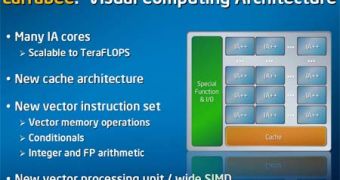Intel has started packing up its gear for the upcoming Spring Developer Forum, that will take place next month is Shanghai, China. As usually, the pre-briefing conference revealed further details about the upcoming products, including a new Itanium processor and six other MP Xeon chips, and this is not all, as the main guest stars of the event seem to be the next-gen Nehalem micro architecture and the FP accelerator known as the Larrabee.
According to Intel's vice president Steve Smith, the Larrabee multi-core graphics chip has nothing in common with AMD's Radeon series or Nvidia's geForce chips, as it is capable of processing all the x86 instruction set that comes implemented into modern processor architectures. The Larrabee is a different breed of graphics chip, with stream processing abilities.
However, Smith would not disclose specific details regarding how many cores will be implemented on the Larrabee silicon. However, the previously disclosed details claim that it will come with 16 graphics cores, each of them ranging beyond the 2 GHz threshold.
Another important aspect of the Larrabee silicon is the fact that it can be easily scaled to fit a few thousands of cores. Intel will pitch the Larrabee multi-core processor as a graphics card, but Pat Gelsinger, the company's senior vice president claims that the chip's hidden powers reside in its floating point engine, able to deliver more than a Teraflop of computing power.
This means that Larrabee will be able to deliver more performance than Nvidia's Tesla cards and AMD's Firestream stream processor cards, but Intel is determined to push things even further: the IA cores would allow x86 code developers to program the whole chip. This eliminates the need for learning additional programming languages, such as Nvidia's CUDA or AMD's CTM. Gelsinger also claims that Larrabee will use "common libraries and run under the same OS as IA processors."
Intel will not bring further details upon Larrabee's technical specifications at the Spring Developer Forum.

 14 DAY TRIAL //
14 DAY TRIAL //